Beta Lactam Antibiotics
Question 1. Write Classification And Uses Of Penicillin.
Answer:
Penicillin is a β-lactam antibiotic.
Classification Of Penicillin
- Natural or long-acting: Penicillin G, Benzathine
- Semisynthetic derivatives
- Acid-resistant alternative to penicillin G: Penicillin V
- Penicillinase-resistant penicillin, i.e. methicillin, oxacillin, cloxacillin
- Extended-spectrum antibiotics:
- Aminopenicillin: Ampicillin, amoxicillin
- Carboxypenicillin: Carbenicillin, ticarcillin
- Ureidopenicillin: Piperacillin, mezlocillin
- β-lactamase inhibitors: Clavulanic acid, sulbactam, tazobactam.
Read And Learn More: Pharmacology Question And Answers
Uses Of Penicillin
Penicillin is a drug of choice for organism caused by organism susceptible to it.
- Dental infections: Penicillin G is effective in most of the common infections in dentistry. It is also used for periodontal abscesses, periapical abscesses, pericoronitis, ulcerative gingivitis, etc. It can also be used prophylactically to cover dental procedures.
- Medical conditions:
- Streptococcal infections: Pharyngitis, tonsillitis, otitis media, rheumatic fever, etc.
- Pneumococcal infections
- Gonorrhea
- Syphilis: Benzathine penicillin is the drug of choice.
- Diphtheria, tetanus, anthrax, actinomycosis infections
- Prophylactic use: To prevent recurrence of rheumatic fever, surgical fever.
Question 2. Write A Note On Ampicillin.
Or
Discuss In Brief The Mechanism Of Action, Therapeutic Uses, And Adverse Affects Of Ampicillin.
Answer:
Ampicillin Mechanism Of Action
Following is the mechanism of action of ampicillin:
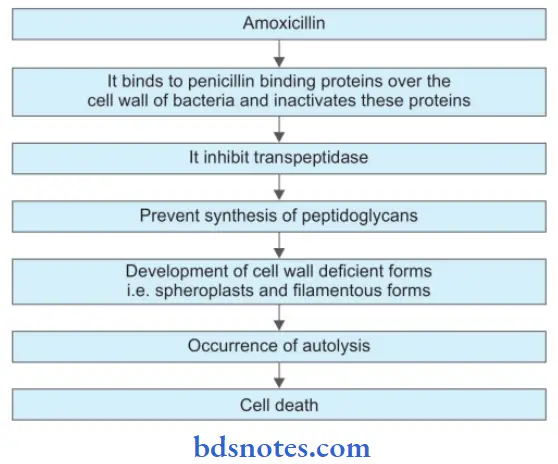
Ampicillin Therapeutic Uses
- In dentistry: Ampicillin and sulbactam combination is used in the treatment of L Ludwig’s angina.
- Upper respiratory infections: Ampicillin is used for the treatment of pharyngitis, sinusitis, otitis media, etc. caused due to S. pyogenes, S. pneumoniae, and H. influenza.
- Urinary tract infections: Ampicillin is used if the patient is sensitive to fluoroquinolones.
- Meningitis: A combination of ampicillin, vancomycin, and cephalosporin mainly third-generation is used to treat meningitis.
- Bacillary dysentery: In some patients, ampicillin is used but most of the strains develop resistance to it.
- Typhoid fever: Ampicillin is indicated to remove the carrier state of the microorganism.
Ampicillin Adverse Effects
- Diarrhea is common after oral administration.
- Hypersensitivity reaction i.e. skin rashes.
- Pain at the site of IM injection.
Question 3. Write Penicillins Therapeutic Uses And Side Effects.
Answer:
Penicillins Therapeutic Uses
- Dental infections: Parenteral penicillin remains effective in the majority of common infections encountered in dentistry, particularly those arising as a sequela of carious lesions and are caused by both aerobic and anaerobic bacteria such as Streptococci, Peptostreptococci, Eubacterium, Prevotella, Porphyromonas, Fusobacterium.
- At ordinary doses, it can be used for periodontal abscess, periapical abscess, pericoronitis, acute suppurative pulpitis, acute necrotizing ulcerative gingivitis (ANUG), oral cellulitis, etc. Penicillin can also be employed prophylactically to cover dental procedures in predisposed patients.
- General medicinal uses: Other medical conditions treated with penicillin G are:
- Streptococcal infections: Pharyngitis, tonsillitis, otitis media, scarlet fever, rheumatic fever, etc. For bacterial endocarditis caused by viridian streptococci, high doses are required in combination with gentamicin.
- Pneumococcal infections (pneumonia, meningitis) are only if the infecting strain is found to be sensitive to penicillins.
- Meningococcal meningitis and other infections.
- Gonorrhea is caused by non-penicillinase-producing N. gonorrhea, etc. that are still sensitive to penicillins.
- Syphilis: Benzathine penicillin is the drug of choice for all stages because T. pallidum has not developed penicillin resistance.
- Diphtheria, tetanus, and other rare infections like gas gangrene, anthrax, and actinomycosis.
Adverse Effects Of Penicillin
Local Irritancy and Direct Toxicity
- Pain at the IM injection site, nausea on oral ingestion, and thrombophlebitis of the injected vein are dose-related expressions of irritancy.
- Toxicity to the brain may be manifested as mental confusion, muscular twitchings, convulsions, and coma.
Penicillins Hypersensitivity
- These reactions are the major problem in the use of penicillins. Individuals with an allergic diathesis are more prone to develop penicillin reactions.
- Frequent manifestations of penicillin allergy are rash, itching, urticaria, and fever.
- Wheezing, angioneurotic edema, serum sickness, and exfoliative dermatitis are less common.
- Anaphylaxis is rare but may be fatal.
Penicillins Superinfections
They are rare with penicillin G because of their narrow spectrum.
Jarisch-Herxheimer Reaction
Penicillin injected in syphilitic patients mostly secondary syphilis may produce shivering, fever, myalgia, exacerbation of lesions, and vascular collapse.
Question 4. Write Classification And Uses Of Cephalosporins.
Answer:
Cephalosporins are a group of semisynthetic antibiotics derived from the fungus cephalosporin.
Classification Of Cephalosporins
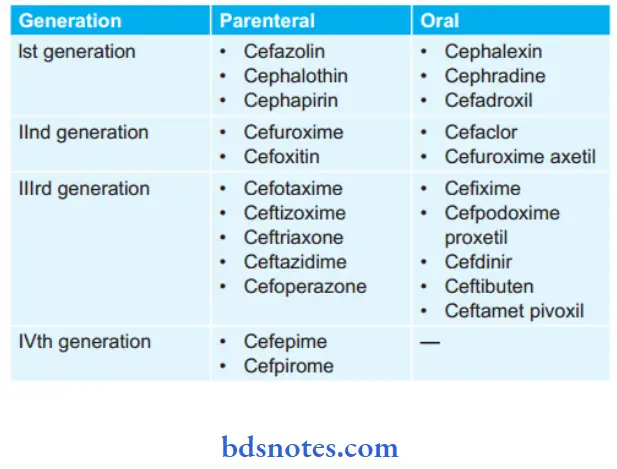
Uses Of Cephalosporins
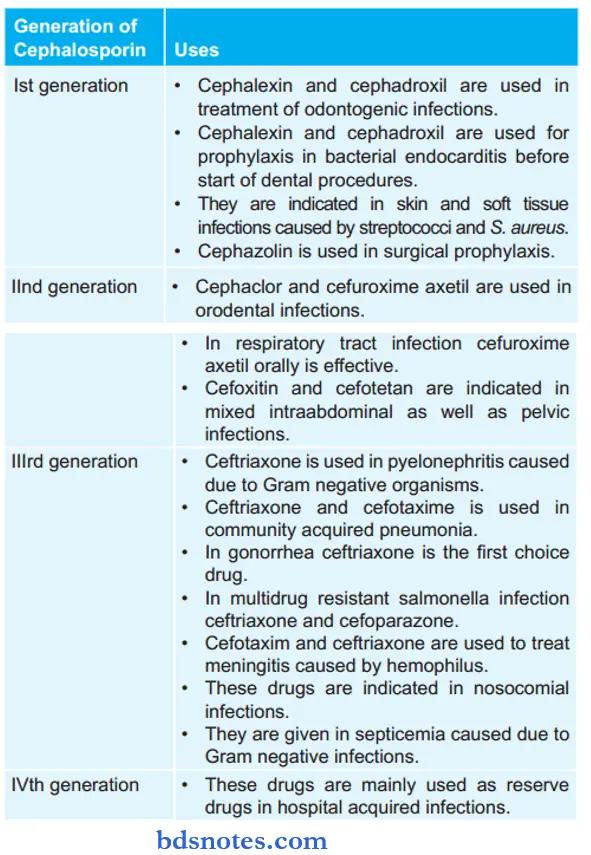
Question 5. Write A Short Note On Beta-Lactam Antibiotics.
Answer:
They are the antibiotics having beta-lactam rings.
- Two major groups are penicillin and cephalosporin
- Monobactum and carbapenems are the new additions.
Question 6. Write Drug Action And Adverse Effects Of Penicillin.
Answer:
Drug Action Of Penicillin
Following is the drug action of penicillin:

Adverse Effects Of Penicillin
Local Irritancy and Direct Toxicity
- Pain at the IM injection site, nausea on oral ingestion, and thrombophlebitis of the injected vein are dose-related expressions of irritancy.
- Toxicity to the brain may be manifested as mental confusion, muscular twitchings, convulsions, and coma.
Hypersensitivity
- These reactions are the major problem in the use of penicillins. Individuals with an allergic diathesis are more prone to develop penicillin reactions.
- Frequent manifestations of penicillin allergy are rash, itching, urticaria, and fever.
- Wheezing, angioneurotic edema, serum sickness, and exfoliative dermatitis are less common.
- Anaphylaxis is rare but may be fatal.
Superinfections
They are rare with penicillin G because of their narrow spectrum.
Jarisch-Herxheimer Reaction
Penicillin injected in syphilitic patients mostly secondary syphilis may produce shivering, fever, myalgia, exacerbation of lesions, and vascular collapse.
Question 7. Write A Short Note On Jarisch Herxheimer Reaction.
Answer:
Jarisch–Herxheimer reaction is the acute exacerbation of signs and symptoms of syphilis during the penicillin treatment.
Penicillin injected in the syphilitic patient may produce shivering, fever, myalgia, exacerbation* of lesions, and even vascular collapse.
- This is due to the sudden release of spirochetal lytic products and lasts for 12–72 hours.
- It does not recur and does not need interruption of therapy.
- Aspirin, corticosteroids, and sedatives afford relief of symptoms.
Question 8. Compare And Contrast Newer Penicillin And Older Penicillin.
Answer:
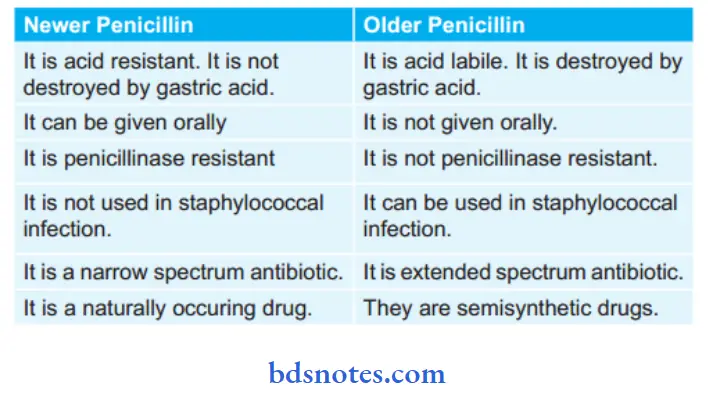
Question 9. Write Important Uses, Side Effects, And Contraindications Of Any Of First Generation Cephalosporins.
Answer:
First-Generation Cephalosporins Uses
- Cephazolin is used for surgical prophylaxis.
- First-generation cephalosporins are used as an alternative to penicillin G mainly in patients who are allergic to penicillin G.
- Cephalexin and cefadroxil are used in the treatment of odontogenic infections.
- Cephalexin and cefadroxil are used for prophylaxis in bacterial endocarditis before the start of dental procedures.
- They are indicated in skin and soft tissue infections caused by streptococci and S. aureus.
First-Generation Cephalosporins Side Effects
- Pain after IM injection occurs. This is so severe with cephalothin as to interdict the IM route. If injected into a vein thrombophlebitis may occur.
- Diarrhea due to alteration of gut ecology or irritative effect is more common with oral ephedrine.
- Hypersensitivity reactions are caused by first-generation cephalosporins which are similar to penicillin but the incidence is lower. The rash is the most common manifestation.
- Cephalothin has low-grade nephrotoxicity.
Question 10. Describe The Pharmacological Action And Uses Of Amoxicillin. Why Is It Combined With Clavulinic Acid?
Or
Write About The Therapeutic Uses Of Amoxicillin.
Answer:
Amoxicillin Pharmacological Action
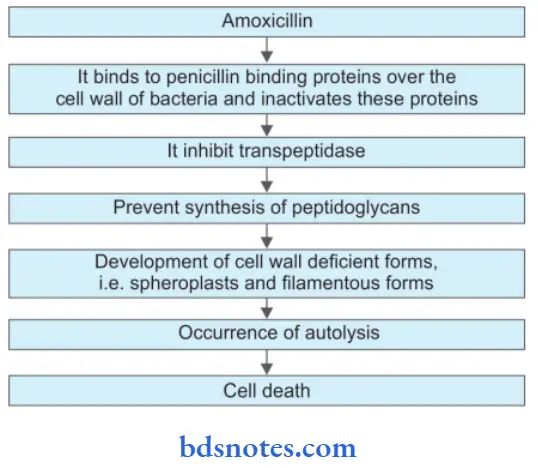
Uses Of Amoxicillin
- It is used to treat Lyme disease.
- It is used to treat urinary tract infections caused by E coli, streptococci, etc.
- It is used to treat typhoid, sub-acute bacterial endocarditis, and gonorrhea.
- It is the most frequently used antibiotic for the treatment of dental infections.
- It is the first choice drug for prophylaxis of local wound infection as well as distant infection following dental surgery in susceptible patients.
Combination Of Amoxicillin And Clavulanic Acid
Amoxicillin is susceptible to degradation by β-lactamase pro- reducing bacteria, which are resistant to a broad spectrum of β-lactam antibiotics, such as penicillin.
Clavulanic acid is a β lactamase inhibitor, so after binding to β lactamase clavulanic acid gets inactivated and is known as a suicide inhibitor. So to prevent the destruction of amoxicillin by β lactamase enzyme amoxicillin is combined with clavulanic acid.
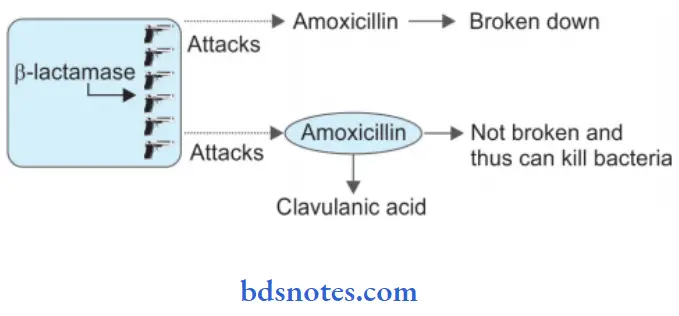
Question 11. Explain The Basis Of Use For The Combination Of Amoxicillin And Clavulanic Acid.
Or
Write A Short Note On Amoxicillin + Clavulanic Acid.
Or
Justify Combination Of Amoxicillin And Clavulanic Acid.
Or
Explain Why It Is Rational To Give Amoxicillin With Clavulanic Acid.
Answer:
Amoxicillin is susceptible to degradation by β-lactamase producing bacteria, which are resistant to a broad spectrum of β-lactam antibiotics, such as penicillin.
Clavulanic acid is a β lactamase inhibitor, so after binding to β lactamase clavulanic acid gets inactivated and is known as a suicide inhibitor.
So to prevent the destruction of amoxicillin by β lactamase enzyme amoxicillin is combined with clavulanic acid. Its route of administration is oral, IM, or IV

Question 12. Classify Antimicrobial Agents.
Answer:
Classification Of Antimicrobial Agents
They are classified into many ways:
On Basis Of Chemical Structure
- Sulfonamides and related drugs: Sulfadiazine and others, sulfones-dapsone, para-aminosalicylic acid (PAS).
- Diaminopyrimidines: Trimethoprim, pyrimethamine.
- Quinolone: Nalidixic acid, norflxacin, ciproflxacin, gatiflxacin, etc.
- β-lactam antibiotics: Penicillins, cephalosporins, monobactams, carbapenems.
- Tetracyclines: Oxytetracycline, doxycycline, etc.
- Nitrobenzene derivatives: Chloramphenicol.
- Aminoglycosides: Streptomycin, gentamycin, amikacin, neomycin, etc.
- Macrolide antibiotics: Erythromycin, clarithromycin, azithromycin, etc.
- Lincosamide antibiotics: Lincomycin, clindamycin.
- Glycopeptide antibiotics: Vancomycin, teicoplanin.
- Oxazolidinones: Linezolid.
- Polypeptide antibiotics: Polymyxin-B, colistin, bacitracin, tyrothricin.
- Nitrofuran derivative: Nitrofurantoin, furazolidone.
- Nitroimidazole: Metronidazole, tinidazole, etc.
- Nicotinic acid derivatives: Isoniazid, pyrazinamide, ethionamide.
- Polyene antibiotics: Nystatin, amphotericin-B, hamycin.
- Azole derivatives: Miconazole, ketoconazole, flconazole.
- Others: Rifampin, spectinomycin, sodium fusidate, cycloserine, viomycin, ethambutol, thiacetazone, clofazimine, and griseofulvin.
On Basis Of Mechanism Of Action
- Inhibit cell wall synthesis: Penicillins, cephalosporins, cycloserine, vancomycin, and bacitracin.
- Cause leakage from cell membranes: Polypeptidespolymyxins, colistin, bacitracin polyenes-amphotericin B, nystatin, hamycin.
- Inhibit protein synthesis: Tetracyclines, chloramphenicol, erythromycin, clindamycin, linezolid.
- Cause misreading of m-RNA code and affect permeability: Aminoglycosides-streptomycin, gentamycin, etc.
- Inhibit DNA gyrase: Fluoroquinolones-ciprofloxacin and others.
- Interfere with DNA function: Rifampin, metronidazole.
- Interfere with DNA synthesis: Acyclovir, zidovudine.
- Interfere with intermediary metabolism: Sulfonamides, sulfones, PAS, trimethoprim, pyrimethamine, ethambutol.
On Basis Of Type Of Organisms Against Which Primarily Active
- Antibacterial: Penicillins, aminoglycosides, erythromycin, etc.
- Antifungal: Griseofulvin, amphotericin B , ketoconazole, etc.
- Antiviral: Acyclovir, amantadine, zidovudine, etc.
- Antiprotozoal: Chloroquine, pyrimethamine, metronidazole, diloxanide, etc.
- Antihelminthic: Mebendazole, pyrantel, niclosamide, diethyl carbamazepine, etc.

On Basis Of Spectrum Of Activity
- Narrow-spectrum: Penicillin G, streptomycin, erythromycin
- Broad-spectrum: Tetracyclines, chloramphenicol.
On Basis Of Type Of Action
Primarily bacteriostatic: Sulfonamides, erythromycin, tetracyclines ethambutol, chloramphenicol clindamycin, linezolid
Primarily bactericidal: Penicillins, cephalosporins, aminoglycosides, vancomycin, polypeptides, nalidixic acid, rifampin, ciprofloxacin, isoniazid, metronidazole, pyrazinamide, cotrimoxazole.
Antibiotics Are Obtained From
- Fungi: Penicillin griseofulvin cephalosporin
- Bacterial: Polymyxin B, tyrothricin, colistin, aztreonam, bacitracin
- Actinomycetes: Aminoglycosides, macrolides, tetracyclines, polyenes, chloramphenicol
Question 13. Classify Penicillins According To Their Antibacterial Spectrum. Mention The Therapeutic Uses And Adverse Effects Of PenicillinG.
Answer:
Classification Of Penicillin According To Its Antibacterial Spectrum
- Narrow spectrum: Penicillin G
- Extended-spectrum penicillin or semi-synthetic penicillin
- Acid-resistant alternative to penicillin G: Penicillin V
- Penicillinase-resistant penicillin, i.e. methicillin, oxacillin, cloxacillin
- Extended-spectrum antibiotics:
- Aminopenicillin: Ampicillin, amoxicillin
- Carboxypenicillin: Carbenicillin, ticarcillin
- Ureidopenicillin: Piperacillin, mezlocillin.
Therapeutic Uses Of Penicillin G
- In Dental infections: Parenteral penicillin G remains effective in the majority of common infections encountered in dentistry, particularly those arising as a sequela of carious lesions and are caused by both aerobic and anaerobic bacteria such as Streptococci, Peptostreptococci, Eubacterium, Prevotella, Porphyromonas, Fusobacterium.
- At ordinary doses, it can be used for periodontal abscess, periapical abscess, pericoronitis, acute suppurative pulpitis, ANUG, oral cellulitis, etc. Penicillin G can also be employed prophylactically to cover dental procedures in predisposed patients.
- General medicinal uses: Other medical conditions treated with Penicillin G are:
- Streptococcal infections: Pharyngitis, tonsillitis, otitis media, scarlet fever, rheumatic fever, etc. For bacterial endocarditis caused by viridian streptococci, high doses are required in combination with gentamicin.
- Pneumococcal infections (pneumonia, meningitis) only if the infecting strain is found to be sensitive to penicillin G.
- Meningococcal meningitis and other infections.
- Gonorrhea is caused by non-penicillinase-producing N. gonorrhea, etc. that are still sensitive to Penicillin G.
- Syphilis: Benzathine penicillin is the drug of choice for all stages because T. pallidum has not developed penicillin resistance.
- Diphtheria, tetanus, and other rare infections like gas gangrene, anthrax, and actinomycosis.
Adverse Effects Of Penicillin G
Local Irritancy And Direct Toxicity
- Pain at the IM injection site, nausea on oral ingestion, and thrombophlebitis of the injected vein are dose-related expressions of irritancy.
- Toxicity to the brain may be manifested as mental confusion, muscular twitchings, convulsions, and coma.
Hypersensitivity
- These reactions are the major problem in the use of penicillins. Individuals with an allergic diathesis are more prone to develop penicillin reactions.
- Frequent manifestations of penicillin allergy are rash, itching, urticaria, and fever.
- Wheezing, angioneurotic edema, serum sickness, and exfoliative dermatitis are less common.
- Anaphylaxis is rare but may be fatal.
Superinfections
They are rare with penicillin G because of their narrow spectrum.
Jarisch-Herxheimer Reaction
Penicillin injected in syphilitic patients mostly secondary syphilis may produce shivering, fever, myalgia, exacerbation of lesions, and vascular collapse.
Question 14. Classify Beta-Lactam Antibiotics. Describe Penicillin Under The Following Headings:
- Mechanism Of Action
- Antimicrobial Spectrum
Answer:
Classification Of Beta-Lactam Antibiotics
Beta-lactam antibiotics consist of penicillins, cephalosporins, carbapenems, and monobactams. They all have β-lactam ring in their chemical structure and so are known as β-lactam antibiotics.
Mechanism Of Action Of Penicillin
Following is the mechanism of action of penicillin:

Antimicrobial Spectrum Of Penicillin
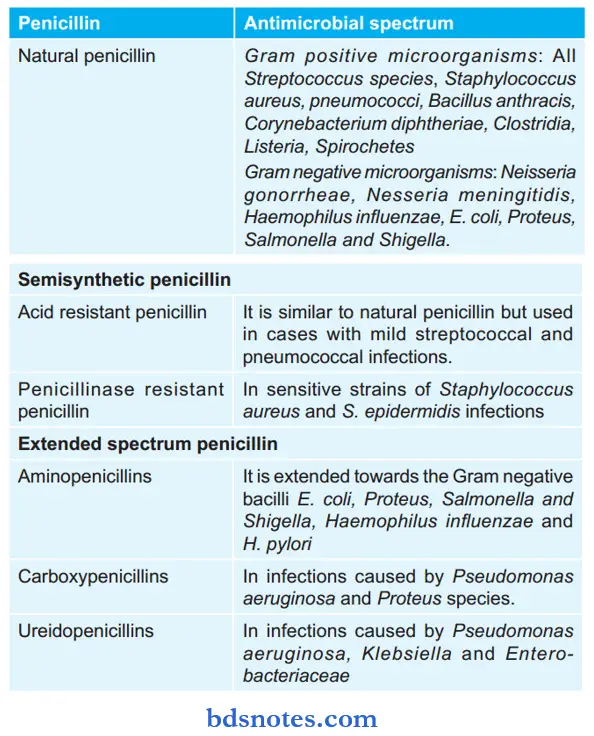
Question 15. Describe Adverse Reactions Of Amoxicillin.
Answer:
Adverse Reactions Of Amoxicillin
- Diarrhea is frequently present.
- Presence of high incidence of rashes. Rashes are more common in patients with AIDS, Epstein-Barr virus infection, or lymphatic leukemia.
- Hypersensitivity is seen in patients who are allergic to penicillin G too.
Question 16. Describe The Prophylactic Uses Of Benzyl Penicillin.
Answer:
Prophylactic Uses Of Benzyl Penicillin
- It is used prophylactically to cover dental procedures in predisposed patients.
- It is used prophylactically before the commencement of dental procedures in patients with bacterial endocarditis caused by viridian streptococci.
- It prevents the recurrence of rheumatic fever.
- It is used prophylactically in surgical prophylaxis along with gentamycin.
- It is used to protect cases of agranulocytosis.
Question 17. Describe The Adverse Effects Of Cephalosporins.
Answer:
Adverse Effects Of Cephalosporins
- Hypersensitivity: Allergic reactions are more commonly present. Allergies are present in the form of skin rashes, urticaria, and rarely anaphylaxis.
- Gastrointestinal disturbances i.e. diarrhea, vomiting, and anorexia
- Cephalothin causes pain at the site of injection. Various IV cephalosporins can lead to thrombophlebitis.
- Cephaloridine leads to nephrotoxicity.
- Cefotetan and cefoperazone show intolerance to alcohol.
- Cefoperazone leads to severe bleeding due to hypoprothrombinemia or thrombocytopenia and/or platelet dysfunction.
Question 18. Write Side Effects And Indications Of Broad-Spectrum Penicillins.
Answer:
Side Effects And Indications Of Broad Spectrum Penicillins
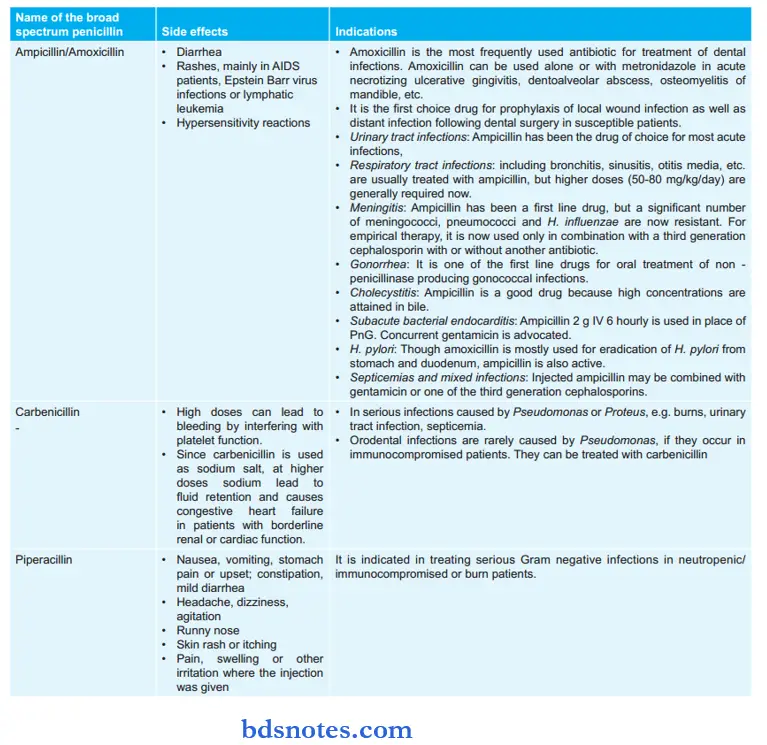

Leave a Reply